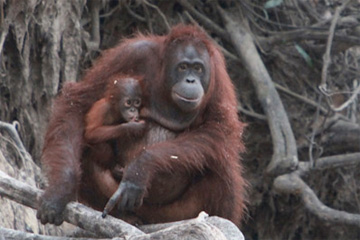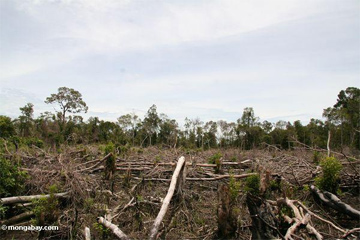 This interview is an excerpt from The WildLife with Laurel Neme, a program that explores the mysteries of the animal world through interviews with scientists and other wildlife investigators. “The WildLife” airs every Monday from 1-2 pm EST on WOMM-LP, 105.9 FM in Burlington, Vermont. You can livestream it at theradiator.org or download the podcast from iTunes, laurelneme.com or laurelneme.podbean.com. This interview is an excerpt from The WildLife with Laurel Neme, a program that explores the mysteries of the animal world through interviews with scientists and other wildlife investigators. “The WildLife” airs every Monday from 1-2 pm EST on WOMM-LP, 105.9 FM in Burlington, Vermont. You can livestream it at theradiator.org or download the podcast from iTunes, laurelneme.com or laurelneme.podbean.com.
Dr. Laurel A. Neme is also the author of ANIMAL INVESTIGATORS: How the World’s First Wildlife Forensics Lab is Solving Crimes and Saving Endangered Species. |
This interview aired in on April 4, 2010 and November 22, 2010. It was transcribed by Ben Kennedy.
Part 1 of 2.
Part 2: Teaching orangutans to be wild – orangutan rehabilitation
Michelle Desilets, Executive Director of the Orangutan Land Trust, spoke with Laurel Neme on her “The WildLife” radio show and podcast about orangutans. In the first part of her interview, they discussed orangutan biology, habits and the interconnected threats, from the pet trade to habitat loss and expansion of oil palm plantations, facing these creatures. The second part covers the process of rehabilitating orangutans and teaching them to be wild.
Orangutans are the largest living arboreal animals and live in the rainforests of Borneo and Sumatra. They’re well-adapted to living in trees, with long arms, long fingers, opposable thumbs/big toes set lower down their hands/feet so that they can better grasp branches, and fully rotational hip joints that allow them to swing in all directions.
 Michelle Desilets |
The orangutan is probably the most intelligent of all of the great apes, especially if intelligence is measured by the ability to problem solve. “A chimpanzee doesn’t have the patience,” Desilets says, “and a gorilla doesn’t seem to have the motivation to problem solve. But the orangutan tends to have the incentive to determine the problem and sit and work at it until it’s solved.” She sums up their differing approaches, noting that “if you give a chimpanzee a screwdriver, he’ll break it; if you give a gorilla a screwdriver, he’ll toss it over his shoulder; but if you give an orangutan a screwdriver, he’ll open up his cage and walk away.” She even provides examples of orangutan innovation, such as their tactic for staying dry. Because orangutans detest rain, they’ll often use leaves to craft umbrellas or construct roofs over their nests.
Michelle Desilets has worked on orangutan conservation alongside Lone Dröscher Nielsen, the internationally well-known champion of these apes, for over 15 years. In 1994, Michelle took her first trip as a volunteer tourist to a national park in Borneo and continued to visit and volunteer over the following years for months at a time. In 1997, she and fellow volunteer Lone Dröscher Nielsen began exploring the creation of a new project in Central Kalimantan to address the swelling numbers of orphaned orangutans and, in 1999, with assistance from Dr. Willie Smits and financial backing from the Gibbon Foundation and the Borneo Orangutan Survival Foundation (BOS) Indonesia, the Nyaru Menteng Orangutan Rehabilitation and Reintroduction Center was born. The rehabilitation center received its first dozen orangutans in 1999 and now has over 600 orangutans in its care, making it the largest such center in the world. Its work has been featured in many media stories, most notably on the BBC’s Orangutan Diary and Animal Planet’s Orangutan Island.
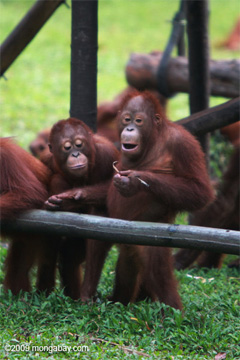 Kalimantan, 2009 |
Michelle Desilets founded the Borneo Orangutan Survival Foundation UK to support the work of Lone Dröscher Nielsen as well as the other activities of BOS Indonesia. As Executive Director of BOS UK, Michelle initiated a number of international campaigns to help orangutans, including campaigns to end the illegal trade of orangutans, to repatriate known smuggled orangutans, and a campaign for sustainable palm oil. She currently sits on several working groups in the Roundtable for Sustainable Palm Oil. She founded and is Executive Director of the Orangutan Land Trust (based in the United Kingdom), which supports the preservation, restoration and protection of land in areas where orangutans naturally exist or have existed in the past. The main aim of the Orangutan Land Trust is to ensure that safe forest areas are set aside for orangutans and other species to form a healthy ecosystem. She spends a good deal of time at the Nyaru Menteng project, and provides an inside look at orangutan conservation on the front lines.
CAREER INSPIRATION
Laurel Neme: What or who inspired you to dedicate yourself to orangutans?
Michelle Desilets: [One summer vacation in Indonesia] I met this little tiny [rescued] orangutan that just stole my heart. His name was Somalia and he was about a year old. He was in a tiny wire cage behind a ranger hut. He was desperately thin and hairless and hunched over, with these big wide eyes. I absolutely fell in love with this little guy, and I just had to do something about him.
…
[I went back at Christmas vacation and] I took care of Somalia and four other rescued orangutans 24/7, living in a very small room sharing a cot bed with five baby orangutans. We made our own diapers out of old towels, and I had to wash them out every day. Somalia would not let go of me. He was permanently attached to my body, as a baby would be to its mother, even when I went to the bathroom or took a shower. If I took a shower, I’d shift him on one side of my body, [wash, and then] turn him on the other side. He just would not let go.
Laurel Neme: Was Somalia your typical orangutan?
Michelle Desilets: [Normally,] orangutans are active in the day, they sleep at night, and they are primarily vegetarians. Not this guy. Somalia was awake all night long, and his food of choice was fried chicken. …A carnivorous, nocturnal orangutan. And, at 4 a.m., he’d crawl out of my arms and release his diaper [to] wake me up. Okay, great, thank you very much. … And I still loved him. He just stole my heart and he’s why I do what I’m doing now. That was 16 years ago.
ABOUT ORANGUTANS
Laurel Neme: What does the name, orangutan, mean?
 Kalimantan, 2006 |
Michelle Desilets: The name orangutan comes from the Malay language. It’s two words: “or-ang” meaning person or people; and “u-tan” is forest. So, quite literally, person of the forest. The natives believed that orangutans were at one time a form of humans that took to the trees and pretended not to be able to speak in order to avoid being put to work. They could just play in the trees if they pretended they couldn’t talk.
There are still some amongst the many different Dyak tribes who have a remnant feeling that there is something about orangutans that makes them human, or at least almost seem it, and that they deserve a certain level of respect.
Laurel Neme: What’s special about orangutans?
Michelle Desilets: We know that, evolutionarily speaking, the orangutan is not quite as close to us as the chimpanzee, and probably the gorilla on the evolutionary tree. If we look at the DNA, [chimpanzees are] almost 99% identical to human, whereas orangutans aren’t quite that much but it is still quite close. So, orangutans share a lot of the features of human beings. They’re one of the great apes. They have no tail.
ORANGUTAN INTELLIGENCE
Laurel Neme: How intelligent are orangutans compared to other apes?
Michelle Desilets: There are lots of ways of measuring intelligence of species. Scientists have done different tests, but most recently, about a year or two ago, some scientists came together and said “if intelligence is measured in the ability to problem solve, then the orangutan wins hands down. It just blows the chimpanzee right off the block.”
Orangutans just have this tenacity. They are motivated to focus on the problem until they solve it. They stick with it.
Laurel Neme: How does that compare to chimpanzees and gorillas?
Michelle Desilets: A chimpanzee doesn’t have the patience, and a gorilla doesn’t seem to have the motivation to problem solve, but the orangutan tends to have the incentive to determine the problem and sit and work at it until it’s solved.
They say that if you give a chimpanzee a screwdriver, he’ll break it; if you give a gorilla a screwdriver, he’ll toss it over his shoulder; but if you give an orangutan a screwdriver, he’ll open up his cage and walk away. I do believe the orangutan is the most intelligent species [of great ape].
ORANGUTAN SPECIES AND SUBSPECIES
Laurel Neme: How many species of orangutans exist? What is there conservation status?
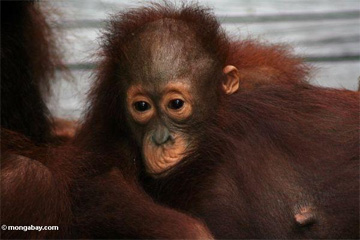 Kalimantan, 2006 |
Michelle Desilets: There are two separate species: Bornean and Sumatran. The Sumatran orangutan, according to the IUCN, is considered to be critically endangered, with about 6,500 left in the world. The Borneo orangutan is considered to be “only” endangered, and the latest data would put them at about 35,000 to 45,000 Bornean orangutans left.
Laurel Neme: What are the differences between the two species?
Michelle Desilets: The Bornean orangutan is shorter but robust, whereas the Sumatran is a little bit leaner and longer. The Bornean tends to have darker hair. The Sumatran tends to have longer and blonder hair, longer beards, mustaches and so forth. The Bornean orangutans have three subspecies, depending on what area of the island you live on.
Laurel Neme: What are the differences between the subspecies of Bornean orangutans?
 Sumatra, 2009 |
Michelle Desilets: The main differences that you can see from looking at them is the color of the hair. The orangutans in eastern Borneo (Pongo pygmaeus morio) are dark purple to almost black in color. The central Bornean orangutans (Pongo pygmaeus wurmbii) are more medium-red in color. Then, as you go further towards the west, the Pongo pygmaeus pygmaeus is a bit blonde. And the texture of the hair is a bit different between them. Some species are more wiry than others.
DIFFERENCES BETWEEN MALE AND FEMALE ORANGUTANS
Laurel Neme: What are some of the differences between male and female orangutans?
Michelle Desilets: The male and female are what is commonly referred to as sexually dimorphic, meaning they show great differences between an adult male and female. The male is about twice the size, on average, twice the weight of female orangutans. Also, as males reach maturity, they will grow these cheek flanges, which we call cheek pads, and a throat sac.
Laurel Neme: What are they used for?
Michelle Desilets: The throat sac is used to create what’s called a long call. [It’s called a] long call by virtue that it lasts a long time and it can be heard for quite a long way. The long calls are a series of escalating belches that the male bellows through the forest in order to see if there other males around. [They’re saying:] “Hey, this is where I am. You might want to stay where you are. I don’t want you in my neck of the woods. And also, if your female, if you like the sound of this, come on over.”
Laurel Neme: [Laughs] Does it work?
Michelle Desilets: The females do judge orangutans by the strength of the long call.
Going back to the cheek pads, scientists believe that these cheek pads are, in a way, meant to direct the sound and amplify it. In fact, I’ve stood a meter in front of a male orangutan making that long call and it’s like standing in front of a speaker at a rock-and-roll concert. You can feel the reverberation through your entire body as he makes this call, and physically the girls like it. The bigger the cheek pads the more handsome the orangutan, as far as female orangutans are concerned.
Laurel Neme: So size does matter. [laughing]
Michelle Desilets: Size does matter in your cheek pads. If you want to talk about their other anatomy, then orangutans are very small. Quite small. Richard Wrangham, author of the book called “Demonic Males” [with Dale Peterson] can talk to you about the differences of the male anatomy between the apes and humans, and what that has to do with their tendency towards violence. His book says the testicular size and amount of testosterone leads directly to how violent a society you create. But that’s an entirely different radio program entirely! We’ll stick with the cheek pads.
ORANGUTAN MORPHOLOGY – HAIR AND FEET
Laurel Neme: Can you describe their hair, and their hands and feet.
Michelle Desilets: Orangutans have the longest hair of any species. They can grow hair on their arms, legs and backs that’s up to three feet long.
They have very long fingers, [although] their thumbs, which are [relatively speaking] quite short, are set further down [the hand], which allows them to make that hoop-like grasp around the branches. Their feet are nearly identical to their hands. Again, they have really long toes that can wrap around the branch, and a big toe that is more like a thumb that hangs low near the ankle to accommodate that hooking.
Laurel Neme: Is that lower thumb or big toe similar to other apes?
Michelle Desilets: That’ll be similar to other apes. But quite so with the orangutans because they’re arboreal mammals. They are the apes that spend their lives in the trees. Chimpanzees and gorillas will go up in trees but they don’t physically live in the trees. They’re more ground-dwelling. Orangutan feet are very well adapted for [arboreal living].
Same with their hip joints, which are fully rotational, like our shoulder joints, so that they can swing in all directions. They can do that with their hips. We can’t because our pelvic structure has a bone that prevents us from lifting our leg directly next to our ears. Even the best Olympic gymnasts can’t do that—but orangutans easily can. That helps their maneuverability through the treetops.
ORANGUTAN HABITAT AND HABITS
Laurel Neme: Where do orangutans live? What kind of habitat to they prefer?
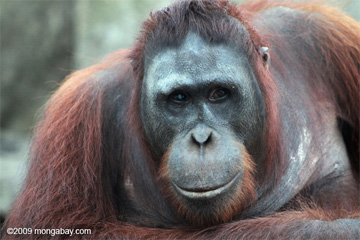 Kalimantan, 2009 |
Michelle Desilets: The orangutan lives almost exclusively in the trees. Its food sources are in the canopy. It builds nests in the canopy. It makes love in the canopy. It travels among highways of branches. There’s very little reason for them to come to the ground, especially in Sumatra where there are predators on the ground, like the tiger. That said, a full grown male orangutan will come down to the ground sometimes and walk across and go up into the next tree rather than crossing along the top—and this has to do with the fact that he’s so heavy that either the branches may not support him or that his arms are getting quite tired, holding up that weight. They will come down to the ground more than the females.
Laurel Neme: Where do they sleep? In the trees?
Michelle Desilets: Orangutans build a new nest every night in the high canopy. They use
these soft tender branches at the end of the tree, [that] are easily folded over and manipulated. They tuck them in and pad them down and add a few more. They are huge nests—very, very comfortable, very squishy and spongy.
Laurel Neme: How big is the nest?
Michelle Desilets: The nest is about 3 to 4 feet across in diameter, depending on the size of the orangutan. Usually it’s in the crook of two branches to give it more support. The baby will sleep in the nest. If the female has an older infant, that infant will build his own nest, usually in the next branch or tree, to be well in sight of the mother.
If it looks like it’s going to be a rainy evening, they’ll even construct a roof on the nest. Again, they’re tool users. Orangutans have been known to carry very large leaves that serve as umbrellas. They’re not stupid. They don’t like the rain. They’re miserable in the rain. So anything they can do to stay out of it, they’ll find a way. Like I said, they’re problem solvers. If they get wet at night, they’ll build a roof. No other ape builds a roof or uses an umbrella—but the orangutan does.
Nests are one of the ways that scientists determine how many orangutans may be living in a portion of forest because orangutans are really hard to spot moving around the forest. More easy to spot are the nests, which stay [in one place]. You can use binoculars to look at these nests. By looking at how dry and wilted the leaves are, you can estimate how long the nests have been there, and then use mathematical formulas to determine the density of orangutans in this area. So nest count is an indicator of how many orangutans are thriving in a certain area.
FOOD SOURCES AS A LIMITING SOCIAL FACTOR
Laurel Neme: Are orangutans normally solitary creatures? And what do they eat?
Michelle Desilets: You might say they’re semi-solitary. They’re usually solitary by virtue of the distribution of food sources in their environment.
Orangutans are known to eat over 600 kinds of foods—mostly fruits, but they are known to also eat leaves and flowers and shoots and roots. In lean times they’ll strip bark off trees and eat the soft pit inside. Sometimes they’ll eat bird eggs, termites, and honey, and they will also often eat soil. The soil has clay and other minerals in it that help settle their tummies.
There have been only a couple of sightings of orangutans eating meat. Sumatran orangutans have been seen to eat slow loris, a small prosimian (most primitive types of living primates) that lives in the forest, and just recently a colleague of mine documented some cannibalism amongst orangutans in Sumatra with unrelated infants.
So, the food sources [for orangutans] are widely distributed but not densely distributed. At any one time only certain trees are providing fruit, and there’s certainly not enough for a whole troop of orangutans to benefit—except when there’s a mass fruiting season. That happens once every 7 to 10 years, where the whole forest comes to life with fruit. Then they can get together—and they will get together. Youngsters will play.
[But,] generally speaking, they travel around on their own. The females with their infants, and sometimes older offspring, might run into some friends from time to time and travel and eat with them for an hour, a day, or a couple of days. But, generally speaking, they’re on their own.
The males will have meetings with females, and their affair may last anywhere from a few hours to a few days. Then they go on their merry ways.
But, if you look at orangutans in captivity, or rescued orangutans from projects that we have, where you put orangutans in a single location and provide them with enough food, then they are extremely sociable animals. They learn from one another. They’re playful. They communicate. So, they have the propensity for being a very social species, but by virtue of their environment they don’t have the opportunities.
ORANGUTAN GEOGRAPHY
Laurel Neme: How many countries have orangutans?
Michelle Desilets: Just two countries. Geography becomes difficult. Sumatra is part of Indonesia. The island of Borneo is made up of three countries. The bulk of Borneo (80% or so) is Indonesian, and that part is called Kalimantan. On the northern edges (of Borneo) you find Sarawak and Sabah, which are two states of Malaysia, and the Kingdom of Brunei in between them. Now, Sabah, Sarawak, Kalimantan and Sumatra have orangutans. So that represents two political countries (Indonesia and Malaysia), but the island is non-politically named Borneo.
Laurel Neme: Does Brunei have orangutans?
Michelle Desilets: Brunei has not had orangutans for a very long time but they have excellent forests. Recently I got a call from somebody working in the Brunei government saying “we’d like to help you with your orangutan problem.” So, we’ll be looking into this, because Brunei may be able to provide some habitat for rescued orangutans. We’ll have to see if the governments will agree to such a thing.
INTERCONNECTED THREATS TO ORANGUTANS
Laurel Neme: What are the main threats to orangutans? It seems there are three main ones: the pet trade; the logging industry destroying their habitat; and the palm oil industry.
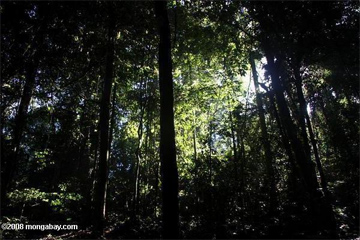
|
Michelle Desilets: That’s right, and they’re all interconnected. Basically, Sumatra and Borneo are like “the new frontiers.” They’re not highly populated because they are quite wild and uninhabitable for humans. But neighboring islands, such as Java, are overpopulated. The Indonesian government has transmigration projects that move communities into these areas and use them as the work force to exploit the natural resources that are found on these two islands. So, population growth, and the need for these countries to economically grow and have products they can sell, drives a lot. We can’t deny them that development opportunity. We can hope that it’s developed in the most sustainable way possible.
So, [governments are] moving people into these areas, and bringing in large multinational companies, often Chinese, Malaysian and others, into areas such as Kalimantan and other areas first of all to [extract] hard wood—that is, the timber used to make your patio furniture and door frames—which will be sold in the West at a premium. Its a very strong, beautiful wood that comes out of the forest of Southeast Asia. At the same time, there’s a huge amount of illegal logging that goes on in both of these areas, in Sumatra and Borneo, and that’s costing the Indonesian government quite a lot of money in lost revenue.
Laurel Neme: How do logging and deforestation impact orangutans?
Michelle Desilets: When you deforest you come across orangutans. Hunting will go up because there’s more accessibility to the animal.
Now, mostly local people don’t go out and say “I would like to have orangutans for dinner tonight. I think I’ll go out and find myself an orangutan and shoot it.” Orangutans are very hard to find in the forest.
If you’re cutting down the forest, you might have some more luck if they’re on the edge, or if they’re wandering into people’s gardens. Then you could pick them off more easily.
Picture the scenario that Dyak hunters go out looking for wild pig. That’s perfectly legal to hunt wild pig. Then they come across a female orangutan with their infant, and they think “That’s great. The female could feed my family for several days.” The infant doesn’t have much meat on it, so maybe [the hunter decides] to keep it or sell it on to somebody as a pet. We come up with loads and loads of orphans. We find them in people’s households. We find them in the marketplace. We find them being shipped off to Jakarta and in the marketplaces there.
The local guy selling the orangutan may get $10 or $20 for it. That’s quite a lot of money for a Dyak living in Borneo. That’s like a month’s wages. When that orangutan sells in the market in Jakarta, it may be for $500 or $1000. But if the buyer is a trader, he’ll put that orangutan onto a ship to the Middle East or America, and that orangutan might fetch $30,000 to $50,000.
THE PET TRADE
Laurel Neme: What’s the impact of the pet trade on orangutans?
Michelle Desilets: Imagine that this orangutan makes it to its destination alive. For that one orangutan, up to 10 other orangutans will perish. For the orangutan being traded, his mother will have been killed. [That’s because] the mother will not give up her baby. You have to kill the mother to get the baby. Other baby orangutans and their mothers will be captured, mothers killed, and some of these orangutans will die in the capture process, or in the marketplace, or in the transport, or shortly after arrival at their destination because they’ve been traumatized, they’ve not been fed properly, they’ve contracted human illnesses, etc. This is where we get these predictions in estimating about 10 orangutans for each one that makes it to it’s destination.
Three or four years ago, some investigators found a hundred baby orangutans in a cage in a zoo in Thailand, and questioned how’d they come to have 101 babies when they only had a handful of breeding females. [The zoo] said it was the result of a very good breeding program. But it’s impossible for 2 or 3 females to have 100 babies. The most they can have is 1 to 3. It was determined they were stolen from the forest of Borneo. They were being trained up to do silly acts, dress up in bikinis and ride bicycles and so forth for tourists. In order to make an orangutan behave this way (they don’t do it because they want to), you usually have to beat them into submission or deprive them of food to get them to perform. And, again, many of them won’t make it because they aren’t being properly cared for. It took 3 years working with the various governments to get these orangutans back to Indonesia back to a rehabilitation program. In the end, we managed to get 48 of those orangutans back. The rest of them were either shipped off to another zoo, a similar zoo in Cambodia, or they perished. But 48 orangutans are alive and living in Indonesia right now in the forest.
Laurel Neme: How does your rehabilitation center (Nyaru Menteng Orangutan Reintroduction Project) get its orangutans?
Michelle Desilets: Most of the orangutans we get are not from international sources because logistics, politics and finances prevent us from being able to pick up all of these orangutans that find themselves out of the country. Most of the orangutans in this project historically have come from markets and local homes—often homes of military personnel and generals and governors and so forth. It’s illegal to capture, kill, hold, or keep as a pet an orangutan anywhere in Indonesia, but nobody has ever been prosecuted for these acts. But our team goes in with a certain office of administrative forestry and we confiscate orangutans form people’s homes, and bring them to the center, or after some public education that we did throughout the region, more and more people were voluntarily handing over their orangutans to the organizations to look after.
Laurel Neme: Do they make good pets?
Michelle Desilets: They’re awfully cute when their babies. They’re so, so adorable. You can understand why somebody would want a pet orangutan. When they’re very tiny, they’re very cute and cuddly. But they grow up very quickly. I know 3 year olds that I have to run away from because they’ll bite my kneecaps off. They’re very active and at 3 and 4 years old, they start to become uncontrollable. Even if you love them and look after them, they are wild animals.
And they are very strong. At 4 or 5 years old, they’re stronger than an average human, and when they become adults, they’re stronger than 4 or 5 men. When they grow up, what are you going to do with them but keep them in a cage? And an orangutan that is healthy will live 40, to 50 to 60 years. That’s quite a commitment for a pet. They aren’t like a dog or a cat. I don’t think people are getting these animals with the idea that they’re going to keep them for 40 to 50 years. They’re illegal as pets. They are cute as first but become a problem after awhile. [That’s why] many owners of orangutans at 3 or 4 years of age, say “please come to pick up my pet. I can’t afford to feed him anymore, or he’s become a troublemaker.”
PALM OIL TRADE
Laurel Neme: How is the palm oil trade connected to threats to orangutans?
Michelle Desilets: Several years ago there was a change in how we were acquiring animals. The project was getting phone calls from [oil palm] plantations, saying that an orangutan was in trouble walking around on it.
A few years ago the oil palm industry boomed. Huge areas of land and forest were being diverted for palm oil. We were finding orangutans that were on the frontline of this development. We were getting calls saying “We’ve just cleared some land. We’ve planted some new plants and we’ve got this weak old orangutan and it’s causing us problems. Can you come get it?” and we became an orangutan removal service for these companies who have the problems with orangutans on their lands. Or we’d get reports that orangutans were in trouble and these were the victims of human-wildlife conflicts.
Laurel Neme: How did those conflicts with palm oil plantations begin?
Michelle Desilets: The palm oil company goes in, clears the forest, fells the timber, and makes some revenue from the timber to tide it over until their [oil palm] plants actually produce some product, which may take five years. So, they’ve cleared the forest and are left with the trees that are really scraggly and a few things on the ground. They [then] have to set fire to that forest [to finish clearing it for planting]. So, you’ve got 10 -20,000 hectares of forest burning, and a lot of it is ‘peat’ forest and it burns like a barbecue. It’s like a fuel. Even after the fires above ground have died down, the fires below ground are burning for months. They can travel below the ground and then when they reach some root of some dry trees, and whoof! They go straight up and a new forest fire erupts. In the course of burning these forests, the peat emits huge amounts of greenhouse gases. If you consider deforestation, Indonesia ranks third in the world in greenhouse gas emissions.
Laurel Neme: What happens once the land is cleared?
Michelle Desilets: Now you’ve got this cleared area. You’ve planted young palms. Maybe those will fragment the forest left, and pushed orangutans into small fragments with dwindling food supplies. There’s competition for food. They’re starving, and so they’ll venture into these newly planted plantations. They’ll go to the young palms and rip them open to get at the soft inner shoots—the yellow leaves at the top—when they do that they destroy the plant. The plant will never grow and produce the product. So they become an agricultural pest.
For plantation owners, that’s a loss of revenue, so why not pay your workers a bounty for the head of an orangutan caught destroying their product? So a bounty of $10 or $20 was placed on the head of these [orangutans]. It’s not easy to take out a grown orangutan. A lot of these workers didn’t have guns, so they used whatever they had on hand.
The rescue workers, hearing about an orangutan in trouble, will come out and find orangutans butchered to death with machetes, beaten to death or unconscious with wooden planks and iron bars, or hung up in wires, thrown in the trash or buried alive. We’ve seen them doused with petrol and set alight. This is what the rescue team is coming across day after day after day, and it reached a crisis point.
Up until a few years ago, we hadn’t seen anything like this very graphic and intense human-wildlife conflict, with so many in this situation. That’s where we say that the unsustainable development of palm oil—palm oil that’s developed at the expense of the remaining habitat of orangutans—is the single greatest threat to the survival of the species. Without the forest, orangutans cannot exist. Many of them will die from the human wildlife conflict that I’ve just described. Many thousands more will die from lingering starvation, not being able to find the food they need in these small fragments of forest.
Laurel Neme: What happens when you find these orangutans?
Michelle Desilets: If we find an orangutan that is still alive, that orangutan will be rescued by our team at Borneo Orangutan Survival. If that orangutan is healthy enough they will make every attempt to save that orangutan and move him to a safe or safer patch of forest, to try to live of their lives there.
If they’re not healthy, or we don’t have a patch of forest to put them in to, we take them back to our center and treat them for injuries and illness. [Because] we’re talking about wild orangutans, and they don’t need to be taught how to be wild, we try not to interact with them to much to maintain that wildness. We feed them and let them get on with things, and then as soon as we find safe land and they’re healthy, a very costly and complicated process of translocation takes place by which they travel by train and by helicopter and are carried over the shoulders of men through the forest and released in the forest far, far away from this kind of development.
Laurel Neme: Do they try and come back to where they used to live?
Michelle Desilets: No, we’re talking very far away. We try to select a similar type of habitat, so they’ll know what kind of food source is here. But they’ll have a new mental map of were food is. It’s an entirely new environment. That’s all we can do because we can’t put them back where the development is happening. What’s going to happen in a month, or six months? We’d just be picking them up again. That’s not satisfactory. So we have to find places where we have indications that in the long term these areas will not be developed and these orangutans will not be at risk any time soon.
Related articles
Teaching orangutans to be wild – orangutan rehabilitation
(12/15/2010) Michelle Desilets, Executive Director of the Orangutan Land Trust, spoke with Laurel Neme on her ‘The WildLife’ radio show and podcast about the process of rehabilitating orphaned orangutans and teaching them to be wild. This is the second in a two-part interview. The first part covered orangutan biology, habits and the interconnected threats, from the pet trade to habitat loss and expansion of oil palm plantations, facing these creatures. This second part focuses on what happens to surviving orangutans.
Orangutans can survive in timber plantations, selectively logged forests
(09/23/2010) Selectively logged forests and timber plantations can serve as habitat for orangutans, suggesting that populations of the endangered ape may be more resilient than previously believed, reports research published in the journal PlosONE. The study, conducted by a team of researchers led by Erik Meijaard of Jakarta-based People and Nature Consulting International, found roughly equivalent population densities between natural forest areas and two pulp and paper plantation concessions in East Kalimantan, Indonesian Borneo.

(07/29/2010) Many of the environmental issues facing Indonesia are embodied in the plight of the orangutan, the red ape that inhabits the islands of Borneo and Sumatra. Orangutan populations have plummeted over the past century, a result of hunting, habitat loss, the pet trade, and human-ape conflict. Accordingly, governments, charities, and concerned individuals have ploughed tens of millions of dollars into orangutan conservation, but have little to show in terms of slowing or reversing the decline. The same can be said about forest conservation in Indonesia: while massive amounts of money have been put toward protecting and sustainable using forests, the sum is dwarfed by the returns from converting forests into timber, rice, paper, and palm oil. So orangutans—and forests—continue to lose out to economic development, at least as conventionally pursued. Poor governance means that even when well-intentioned measures are in place, they are often undermined by corruption, apathy, or poorly-designed policies. So is there a future for Indonesia’s red apes and their forest home? Erik Meijaard, an ecologist who has worked in Indonesia since 1993 and is considered a world authority on orangutan populations, is cautiously optimistic, although he sees no ‘silver bullet’ solutions.

(03/01/2010) It is no secret that orangutans are threatened with extinction because their rain forests are being destroyed at an alarming rate. Ten years ago, Shawn Thompson, a writer, former journalist and university professor, set out to chronicle the threat to orangutans in a book released in March 2010. The book is called The Intimate Ape: Orangutans and the Secret Life of a Vanishing Species. The book spends most of the time talking about the nature of orangutans and the relationships between orangutans and people. But the ultimate underlying message is there about the source of the peril to orangutans and the solution. Thompson says that the problem of saving orangutans has to do with communications and human nature.
Orangutans vs palm oil in Malaysia: setting the record straight

(01/16/2010) The Malaysian palm oil industry has been broadly accused of contributing to the dramatic decline in orangutan populations in Sabah, a state in northern Borneo, over the past 30 years. The industry has staunchly denied these charges and responded with marketing campaigns claiming the opposite: that oil palm plantations can support and nourish the great red apes. The issue came to a head last October at the Orangutan Colloquium held in Kota Kinabalu. There, confronted by orangutan biologists, the palm oil industry pledged to support restoring forest corridors along rivers in order to help facilitate movement of orangutans between remaining forest reserves across seas of oil palm plantations. Attending NGOs agreed that they would need to work with industry to find a balance that would allow the ongoing survival of orangutans in the wild. Nevertheless the conference was still marked by much of the same rhetoric that has characterized most of these meetings — chief palm oil industry officials again made dubious claims about the environmental stewardship of the industry. However this time there was at least acknowledgment that palm oil needs to play an active role in conservation.
Palm oil both a leading threat to orangutans and a key source of jobs in Sumatra
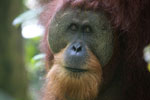
(09/24/2009) Of the world’s two species of orangutan, a great ape that shares 96 percent of man’s genetic makeup, the Sumatran orangutan is considerably more endangered than its cousin in Borneo. Today there are believed to be fewer than 7,000 Sumatran orangutans in the wild, a consequence of the wildlife trade, hunting, and accelerating destruction of their native forest habitat by loggers, small-scale farmers, and agribusiness. Gunung Leuser National Park in North Sumatra is one of the last strongholds for the species, serving as a refuge among paper pulp concessions and rubber and oil palm plantations. While orangutans are relatively well protected in areas around tourist centers, they are affected by poorly regulated interactions with tourists, which have increased the risk of disease and resulted in high mortality rates among infants near tourist centers like Bukit Lawang. Further, orangutans that range outside the park or live in remote areas or on its margins face conflicts with developers, including loggers, who may or may not know about the existence of the park, and plantation workers, who may kill any orangutans they encounter in the fields. Working to improve the fate of orangutans that find their way into plantations and unprotected community areas is the Orangutan Information Center (OIC), a local NGO that collaborates with the Sumatran Orangutan Society (SOS).
Rehabilitation not enough to solve orangutan crisis in Indonesia
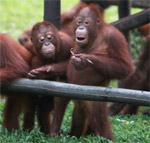
(08/20/2009) A baby orangutan ambles across the grass at the Borneo Orangutan Survival Foundation’s Nyaru Menteng rehabilitation center in Central Kalimantan, in the heart of Indonesian Borneo. The ape pauses, picks up a stick and makes his way over to a plastic log, lined with small holes. Breaking the stick in two, he pokes one end into a hole in an effort to extract honey that has been deposited by a conservation worker. His expression shows the tool’s use has been fruitful. But he is not alone. To his right another orangutan has turned half a coconut shell into a helmet, two others wrestle on the lawn, and another youngster scales a papaya tree. There are dozens of orangutans, all of which are about the same age. Just outside the compound, dozens of younger orangutans are getting climbing lessons from the Borneo Orangutan Survival Foundation (BOS) staff, while still younger orangutans are being fed milk from bottles in a nearby nursery. Still more orangutans—teenagers and adults—can be found on “Orangutan Island” beyond the center’s main grounds. Meanwhile several recently wild orangutans sit in cages. This is a waiting game. BOS hopes to eventually release all of these orangutans back into their natural habitat—the majestic rainforests and swampy peatlands of Central Kalimantan, on the island of Borneo. But for many, this is a fate that may never be realized.
Orangutan guerrillas fight palm oil in Borneo
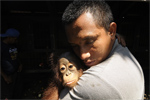
(06/01/2009) Despite worldwide attention and concern, prime orangutan habitat across Sumatra and Borneo continues to be destroyed by loggers and palm oil developers, resulting in the death of up to 3,000 orangutans per year (of a population less than 50,000). Conservation groups like Borneo Orangutan Survival report rescuing record numbers of infant orangutans from oil palm plantations, which are now a far bigger source of orphaned orangutans than the illicit pet trade. The volume of orangutans entering care centers is such that these facilities are running out of room for rescued apes, with translocated individuals sometimes waiting several months until suitable forest is found for reintroduction. Even then they aren’t safe; in recent months loggers have started clearing two important reintroduction sites (forests near Bukit Tigapuluh National Park in Sumatra and Mawas in Central Kalimantan). Meanwhile across half a dozen rehabilitation centers in Malaysia and Indonesia, more than 1,000 baby orangutans—their mothers killed by oil palm plantation workers or in the process of forest clearing—are being trained by humans for hopeful reintroduction into the wild, assuming secure habitat can be found. Dismayed by the rising orangutan toll, a grassroots organization in Central Kalimantan is fighting back. Led by Hardi Baktiantoro, the Center for Orangutan Protection (COP) has mounted a guerrilla-style campaign against companies that are destroying orangutan habitat in Kalimantan, the Indonesian part of Borneo.
(05/24/2006) A look at conservation efforts in Kalimantan, on the island of Borneo. I’m in Tanjung Puting National Park in southern Kalimantan on the island of Borneo. At 400,000 hectares (988,000 acres) Tanjung Puting is the largest protected expanse of coastal tropical heath and peat swamp forest in southeast Asia. It’s also one of the biggest remaining habitats for the critically endangered orangutan, the population of which has been great diminished in recent years due to habitat destruction and poaching. And orangutans have become the focus of a much wider effort to save Borneo’s natural environment. We are headed to Campy Leakey, named for the renowned Kenyan paleontologist Louis Leakey. Here lies the center of the Orangutan Research conservation Project. Established by Birute Mary Galdikas, a preeminent primatologist and founder of the Orangutan Foundation International (OFI), the project seeks to support the conservation and understanding of the orangutan and its rain forest habitat while rehabilitating ex-captive individuals. The Orangutan Research conservation Project is the public face of orangutan conservation in this part of Kalimantan, the Indonesia-controlled part of Borneo. Borneo, the third largest island in the world, was once home to some of the world’s most majestic, and forbidding forests. With swampy coastal areas fringed by mangrove forests and a mountainous interior, much of the terrain was virtually impassable and unexplored. Headhunters ruled the remote parts of the island until a century ago.



